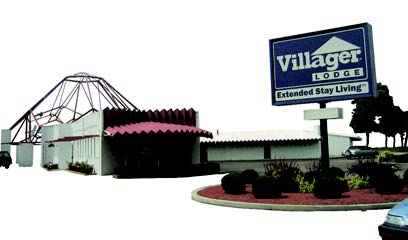The Snow Flake Motel in St. Joseph, Michigan, wears a tricky disguise: a dull sign that reads “Villager Lodge.” Thirty-five states (plus Mexico and Canada) host the Villager Lodge chain, but the Snow Flake Motel (alias Villager Lodge) is the only VL property listed in the National Register of Historic Places. Architourists insist the Snow Flake Motel, completed in 1962, is a Frank Lloyd Wright design, though most visitors are purely interested in the motel’s ability (much like the eighties super-twin Zan) to form a giant snowflake. The motel’s fifty-six rooms are arranged in six V-shaped units that form a large, modernist, six-pointed snowflake, embellished with saw-tooth roofs and several geodesic domes in skeletal form, made of rubber tubing.
For years, St. Joseph, Michigan, has served as a getaway for resorters from the city (known as FCPs—F*ckin’ Chicago People—by the year-rounders). From the early 1900s up through the 1960s, St. Joseph, along with its twin city of Benton Harbor, offered beaches, mineral baths, and the famously longhaired House of David baseball team (a prosperous religious community in Benton Harbor). Benton Harbor’s early luxury hotels are gone and the Snow Flake Motel has not fared well either. Despite its state of total disrepair, the Snow Flake still seduces architect and historian types, as well as extended-stay visitors who come for the flophouse rates ($135/week). The motel’s few occupied rooms are filled with a couple dozen more stuffed animals than one normally takes on a road trip.
Owner Mr. Patel, who would not give his full name, had high hopes for this unique property when he bought it, including the restoration of the motel to its original Wrightian glory. But, as it turns out, the motel possesses a complex pedigree—as an architectural mutt if not a bastard. The Snow Flake Motel was actually designed by the shadowy William Wesley Peters, Wright’s apprentice and son-in-law. Educated as an engineer, Peters made the calculations for Wright’s Fallingwater and the Guggenheim Museum.
In 1930, Peters first arrived at Wright’s Arizona enclave, Taliesin West, as the school’s first fellow. Five years later, he married Wright’s adopted daughter, Svetlana. When Svetlana Peters died in a car accident, Frank Lloyd Wright’s eccentric wife set Peters up with Joseph Stalin’s daughter, also named Svetlana (Mrs. Wright perceived Svetlana II as Svetlana I’s reincarnation) and they married. It’s hard to believe that the man who married Stalin’s daughter made buildings that looked like snowflakes, and yet the design of the motel is, if there is such a thing, a serious, and even severe snowflake. Unlike the more cartoonish designs found in theme parks, the Snow Flake Motel is complex and sophisticated, and sensitive to the elements of space, light, and community. The motel was once embellished with iron gates featuring the snowflake design (these were sold), along with fountains and a geometric swimming pool set under the trademark domes. Despite the motel’s architectural riches, Mr. Patel is bitter and uninterested in the two Svetlanas. No one agreed to finance his proposed preservation/renovation project and now he’s stuck with a rotting snowflake. The Frank Lloyd Wright Foundation distinctly forbade Mr. Patel from attaching the motel’s original Snow Flake sign to the disintegrating structure.
“If I win the lottery, I’d like to buy a bulldozer,” Mr. Patel told me. He sees no potential to improve business. His website maintains a more upbeat timbre with a constant muzak™ loop of “It’s a Wonderful Life” playing in the background. Fittingly, one of the Snow Flake’s original luxury offerings was an individual icemaker in each room. Now, Mr. Patel promises free parking, in-room microwave and refrigerator, cable TV, and proximity to Lake Michigan “with excellent fishing available” instead.





